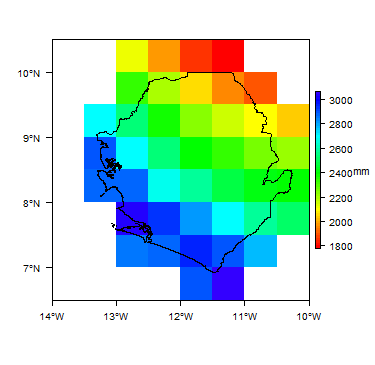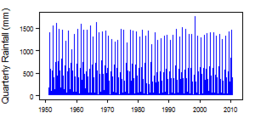Hydrogeology of Sierra Leone: Difference between revisions
No edit summary |
No edit summary |
||
| Line 17: | Line 17: | ||
{| class = "wikitable" | {| class = "wikitable" | ||
|- | |- | ||
|Estimated Population in 2013* || | |Estimated Population in 2013* || 6,092,075 | ||
|- | |- | ||
|Rural Population (% of total) (2013)* || | |Rural Population (% of total) (2013)* || 60.8% | ||
|- | |- | ||
|Total Surface Area* || | |Total Surface Area* || 72,180 sq km | ||
|- | |- | ||
|Agricultural Land (% of total area) (2012)* || | |Agricultural Land (% of total area) (2012)* || 56.8% | ||
|- | |- | ||
|Capital City || | |Capital City || Freetown | ||
|- | |- | ||
|Region || | |Region || Western Africa | ||
|- | |- | ||
|Border Countries || | |Border Countries || Guinea, Liberia | ||
|- | |- | ||
|Annual Freshwater Withdrawal (2013)* || | |Annual Freshwater Withdrawal (2013)* || 212.2 Million cubic metres | ||
|- | |- | ||
|Annual Freshwater Withdrawal for Agriculture (2013)* || | |Annual Freshwater Withdrawal for Agriculture (2013)* || 21.5% | ||
|- | |- | ||
|Annual Freshwater Withdrawal for Domestic Use (2013)* || | |Annual Freshwater Withdrawal for Domestic Use (2013)* || 52.3% | ||
|- | |- | ||
|Annual Freshwater Withdrawal for Industry (2013)* || | |Annual Freshwater Withdrawal for Industry (2013)* || 26.2% | ||
|- | |- | ||
|Rural Population with Access to Improved Water Source (2012)* || | |Rural Population with Access to Improved Water Source (2012)* || 42.4% | ||
|- | |- | ||
|Urban Population with Access to Improved Water Source (2012)* || | |Urban Population with Access to Improved Water Source (2012)* || 87.1% | ||
|} | |} | ||
| Line 88: | Line 88: | ||
==Geology== | ==Geology== | ||
The geology map shows a simplified version of the geology at a national scale. More information is available in the report [http://www.bgs.ac.uk/africagroundwateratlas/fulldetails.cfm?id=AGLA060003 UN (1988)] (see References section, below). | |||
[[File:Sierra Leone_Geology.png | center ]] | |||
==Hydrogeology== | |||
The hydrogeology map below shows a simplified version of the type and productivity of the main aquifers at a national scale (see [[Aquifer properties| the Aquifer properties resource page]] for more details). | |||
More information on the hydrogeology of Burundi is available in the report [http://www.bgs.ac.uk/africagroundwateratlas/fulldetails.cfm?id=AGLA060003 UN (1988)] (see References section, below). | |||
[[File:Sierra Leone_Hydrogeology.png]] [[File: Hydrogeology_Key.png | 500x195px]] | [[File:Sierra Leone_Hydrogeology.png]] [[File: Hydrogeology_Key.png | 500x195px]] | ||
==Groundwater management== | |||
Information on groundwater sources (water points) is collected in certain districts, but there is no central national database. Borehole logs with geological information are not readily available. | |||
=== Transboundary aquifers=== | === Transboundary aquifers=== | ||
Revision as of 14:24, 28 September 2015
Africa Groundwater Atlas >> Hydrogeology by country >> Hydrogeology of Sierra Leone
Most of the textual information on this page was taken from the chapter on the Congo in the report ‘Groundwater in North and West Africa’ (UN 1988). This information is outdated. If you have more recent information on the hydrogeology of the Sierra Leone, please get in touch.
Compilers
Dr Kirsty Upton and Brighid Ó Dochartaigh, British Geological Survey, UK
Geographical Setting

General
| Estimated Population in 2013* | 6,092,075 |
| Rural Population (% of total) (2013)* | 60.8% |
| Total Surface Area* | 72,180 sq km |
| Agricultural Land (% of total area) (2012)* | 56.8% |
| Capital City | Freetown |
| Region | Western Africa |
| Border Countries | Guinea, Liberia |
| Annual Freshwater Withdrawal (2013)* | 212.2 Million cubic metres |
| Annual Freshwater Withdrawal for Agriculture (2013)* | 21.5% |
| Annual Freshwater Withdrawal for Domestic Use (2013)* | 52.3% |
| Annual Freshwater Withdrawal for Industry (2013)* | 26.2% |
| Rural Population with Access to Improved Water Source (2012)* | 42.4% |
| Urban Population with Access to Improved Water Source (2012)* | 87.1% |
* Source: World Bank
Climate
-
Koppen Geiger Climate Zones
-
Average Annual Precipitation
-
Average Temperature
For further detail on the climate datasets used see the climate resources section.
Surface water
|
|
 |
Soil
 |
Land cover
 |
Geology
The geology map shows a simplified version of the geology at a national scale. More information is available in the report UN (1988) (see References section, below).

Hydrogeology
The hydrogeology map below shows a simplified version of the type and productivity of the main aquifers at a national scale (see the Aquifer properties resource page for more details).
More information on the hydrogeology of Burundi is available in the report UN (1988) (see References section, below).
Groundwater management
Information on groundwater sources (water points) is collected in certain districts, but there is no central national database. Borehole logs with geological information are not readily available.
Transboundary aquifers
For further information about transboundary aquifers, please see the Transboundary aquifers resources page
References
The following report provides more information on the geology and hydrogeology of Sierra Leone. It, and others, can be accessed through the Africa Groundwater Literature Archive
United Nations. 1988. Groundwater in North and West Africa: Sierra Leone. United Nations Department of Technical Cooperation for Development and Economic Commission for Africa. Department of Technical Cooperation for Development and Economic Commission for Africa, Natural Resources/Water Series No. 18.
Return to the index pages
Africa Groundwater Atlas >> Hydrogeology by country >> Hydrogeology of Sierra Leone








